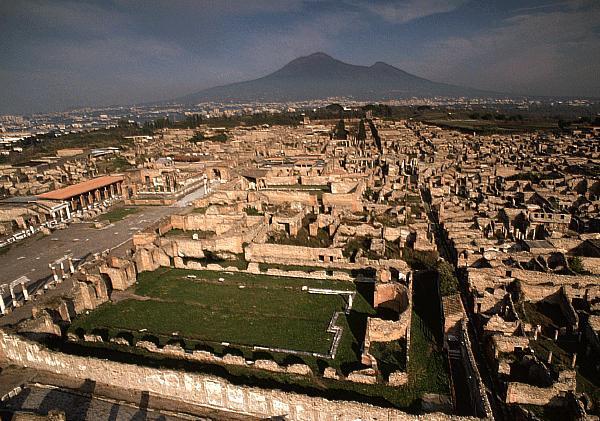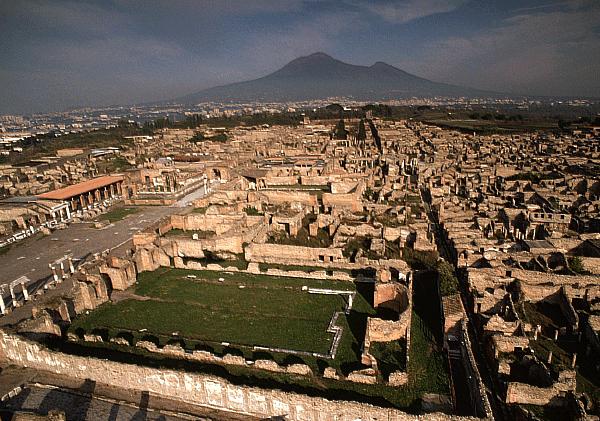
The Archaeological Site of Pompeii
One of the most famous archaeological sites in the world !!!
The Archaeological Site of Pompeii shows the remains of the homonymous ancient city buried under a blanket of ash and lapilli during the eruption of Vesuvius in 79 d.C. !!!
The findings as a result of works, begun at the era of Carlo III di Borbone, are one of the best examples of Roman life, as well as the center of the best preserved of that era. Most of the recovered artifacts (in addition to simple utensils of daily use also frescoes, mosaics and statues), is present today at the Archaeological Museum of Naples.
The analysis in the area, which in the first decade of the new millennium has been constantly visited by over two million people a year, was found to be in 2014 the second Italian site for number of visitors, with 2,621,803 people. In 1997, to preserve the integrity and underline its importance, the Ruins have become part of the UNESCO World Heritage list.
Pompeii was founded by Osci around the VII century BC, not far from the river Sarno, although several witnesses attribute the first human settlements as early as the ninth century BC. During the Oscan period, the village, important road junction, with roads Cuma, Nola and Stabiae, was surrounded by walls and reached an extension of 63 hectares. The center analyzes the influences suffered before the Greeks, in the period between 525 and 474 BC, and then of the Etruscans; was conquered then by the Samnites, which descends from the mountains, they laid employed by Nocera. It was under the latter that the village became a thriving commercial hub, with a thriving little harbor and surrounded by walls, built around 300 B.C. ..
Passed under the rule of the Romans in the third century BC, continued his development, exporting, throughout the Mediterranean, olive oil and wine, of which he was producer especially in the period of the second century BC. In recent years we witnessed, in addition, also to a strong urban development, with the construction of the Forum, the Temple of Jupiter, Iside and the Basilica, as well as numerous houses and residential villas. Became, to be precise, the first Municipium, also enjoying a partial independence, thanks to the support provided during the Second Punic War and then Cologne, by the name of Cornelia Veneria Pompeianorum, following the conquest by Sulla in 89 BC, during the Social Wars. The area was hit by a violent earthquake in 62, and the city was badly damaged, partly repaired promptly. In 79 the city was buried under a blanket of ash and lapilli, erasing it completely. In subsequent years, the area, arid, barren, was not subject to restocking and despite some research conducted in the first century, was not seen again, remaining buried for nearly 1700 years.
The first excavations in Pompeii occurred beginning in 1748, by order of Carlo III di Borbone, following the success of the discoveries of Herculaneum: polls were conducted by Rocque Joaquin de Alcubierre, who, believing they are on the trail of the ancient Stabiae, unearthed near the hill of the city different coins and objects from the Roman period, as well as portions of buildings, promptly covered after the exploration. The explorations were soon abandoned because of poor recoveries and resumed only in 1754. In 1763, thanks to the discovery of an epigraph, which spoke clearly of the Res Publica Pompeianorum, it was felt that it was the ancient city of Pompeii. With Maria Carolina, wife of Ferdinando IV, and the Engineer Francesco La Vega, part of the area was brought to light. It was during the era of the French that the excavations enjoyed a moment of good fortune: the city wall was detected and reported almost entirely. Thanks to the publications wanted by Carolina, Pompeii fame grew throughout Europe, becoming obligatory stop on the Grand Tour.
With the return of the Bourbons, the site experienced a period of stagnation: if you exclude Francesco I, Ferdinando II and Francesco II, the Ruins were used only as a place to bring visiting guests to court. Following the unification of Italy and especially thanks to higher disposable income, under the guidance of Giuseppe Fiorelli, he witnessed a rapid resumption of the investigation, in an orderly manner, with the first division of the city into regiones and insulae. In 1863 was introduced the technique of the casts, and, between 1870 and 1885, he was drafted the first map of the entire Pompeii area.
For more information on the beauties and the attractions of our region, please contact the Booking Office (+39 0817776423) or write to prenotazioni@villasignorini.it
VILLA SIGNORINI: THE FINE ART OF RECEIVING




